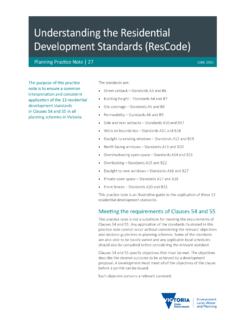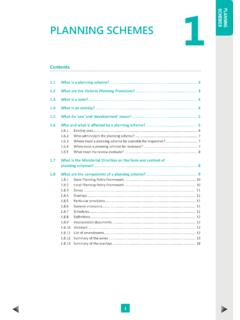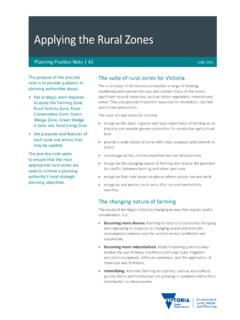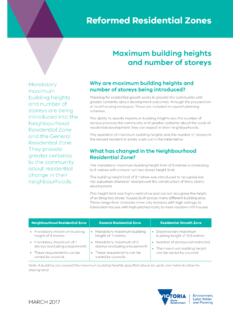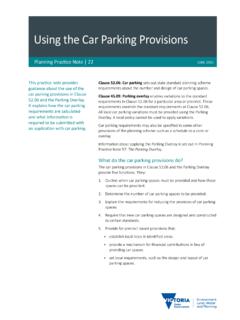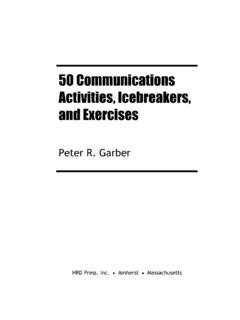Transcription of Planning requirements for heliports and helicopter landing ...
1 helicopter land use definitionsClause 74 of the Victoria Planning Provisions (VPP) defines two helicopter related land uses: Heliport A heliport is not separately defined in Clause 74 but is included within the definition of transport terminal. A transport terminal is defined as land used to assemble and distribute goods or passengers. It includes facilities to park and manoeuvre vehicles. A heliport would normally have one or more helipads, with facilities for passenger handling such as a terminal building. It may also include facilities such as a hangar, refuelling and lighting. helicopter landing siteLand used for the take off and landing of a helicopter , with or without a permanent landing pad, but without permanent facilities for the assembly and distribution of goods or passengers. A helicopter landing site may range from a permanent and constructed landing pad to an unprepared site with no new buildings and does helicopter activity become land used for a helicopter landing site?
2 The Victorian Civil and Administrative Tribunal (VCAT) has considered the question of whether a helicopter landing site constitutes a use of land in a number of cases including Mornington Peninsula SC v Inchalla Nominees Pty Ltd (Red Dot) [2008] VCAT 399 and Mornington Peninsula SC v Lindsay Edward Fox (et al) [2003] VCAT Tribunal has found that a helipad use could be regular, intermittent or occasional, but would need to be more than an isolated or fortuitous landing or take requirements for heliports and helicopter landing sitesPlanning Practice Note | 75 JUNE 2015 The purpose of this practice note is to:1. Explain how helicopter activity is regulated by the Planning system. 2. Provide guidance to applicants and responsible authorities on preparing and assessing an application under Clause of the Planning scheme. The clause applies to proposals to use or develop land for a heliport or a helicopter landing site. Planning Practice Note 75 | Planning requirements for heliports and helicopter landing sites 2 Helicopters and airspace Once a helicopter is in the air, it is beyond Planning control.
3 Two independent statutory authorities are responsible for administering federal legislation and regulations for airspace management, including helicopters in flight: The Civil Aviation Safety Authority (CASA)Established by the Civil Aviation Act 1988 and responsible for administering the Civil Aviation Regulations 1988, CASA conducts safety regulation of civil air operations. Airservices AustraliaEstablished in 1995 and responsible for airspace management, aeronautical information, aviation communications, radio navigation aids, aviation rescue and fire fighting services. Flying overheadPlanning consideration of a heliport or helicopter landing site does not generally extend to a helicopter flying overhead. For areas of controlled airspace, Airservices Australia is responsible for air traffic services, including managing designated flight paths. For areas of uncontrolled airspace, Civil Aviation Regulations 1988 stipulate that a helicopter pilot must not fly over a city, town or populous area at a height lower than 1000 feet, or 500 feet over any other area.
4 This does not apply if a helicopter is flying at a designated altitude, for example a flight path in controlled airspace. helicopter flight pathsHelicopters are a unique form of aircraft characterised by flexibility in flight and near vertical ascent and descent. This allows them to land virtually anywhere and this often requires variable flight paths. While land use Planning does consider flight paths near to airports, it is not always necessary or appropriate to do so for helicopter landing sites. Airservices Australia is a federal statutory authority responsible for ensuring that pilots comply with the Air Navigation (Aircraft Noise) Regulations 1984. The authority also provides air traffic management for Melbourne s controlled airspace, which includes designating flight paths for helicopters. For helicopter landing sites that are not in the vicinity of controlled airspace, flight paths are not approved. The operator must adhere to Visual Flight Rules and Civil Aviation Regulations which are based on safety.
5 For helicopter landing sites or heliports that are of significant community concern, there is an opportunity for a third party or the council to participate in a CASA administered process to develop a Fly Neighbourly Advice with the helicopter operator (see Dispute resolution on page 5). If it is imperative that the flight path be maintained for a heliport or helicopter landing site, for example a hospital helipad access, a Planning authority may consider implementing a Design and Development Overlay on adjacent land to restrict building height levels on sites underlying the designated flight path. Do I need a Planning permit under Clause Planning permit is required to use land for a helicopter landing site or a heliport under Clause of the Victoria Planning Provisions unless the use meets one of the exemptions below. This includes if it is ancillary to another use of the development (buildings and works) related to the use of land for a helicopter landing site or heliport requires a Planning permit irrespective of whether the use is exempt.
6 This ensures that any impacts of the development can be adequately assessed. ExemptionsVictoria s Planning system recognises that some helicopter functions are necessary to properly carry out rescue and emergency services, public land management and agricultural activities, which do not require a Planning permit in Clause to use land for a helicopter landing site. There are also circumstances where the transient use of land for a helicopter landing site does not require a Planning permit, if conditions are met. Emergency services No permit is required under any provision of the Planning scheme to use land for a helicopter landing site that is used by a helicopter engaged in the provision of emergency service Practice Note 75 | Planning requirements for heliports and helicopter landing sites 3 This can include hospitals, police, search and rescue and fire service helicopter landing sites, including training and the emergency landing of a helicopter due to a weather event or technical problem.
7 Agriculture No permit is required under any provision of the Planning scheme to use land for a helicopter landing site that is used by a helicopter engaged in agricultural activity in conjunction with the use of any land for can include flights for purposes such as spraying, dusting and fertilising operations and herding cattle. The purpose of the flight must have a direct link to the carrying out of agricultural activity on the land. It does not include private transport to and from other parts of the property or scenic tourist flights. Public land management No permit is required under any provision of the Planning scheme to use land for a helicopter landing site that is used by a helicopter engaged in the provision of public land management activities conducted by or on behalf of the Department of Environment, Land, Water and Planning (DELWP) and Parks Victoria whether on private land or not. Examples of the type of activity undertaken by helicopters owned or contracted by DELWP and Parks Victoria may include bushfire fuel reduction burning operations, sling loading materials, general compliance operations, fire training, crop spraying and locust control.
8 General No permit is required under any provision of the Planning scheme to use land for a helicopter landing site where the landing point is located more than 500 metres from a building used for a sensitive use that is not associated with the helicopter operation and more than 200 metres from a shipping channel in the Port of Melbourne, provided: Frequency limitation: The number of flight movements does not exceed eight in a 30 day period and four in a 24 hour period. The take off and landing of a helicopter are calculated as separate flight movements. Time limitation: Flight movements do not take place before 7am or after sunset on a weekday. Flight movements do not take place before 8am or after sunset on a weekend or holiday. The separation distance, frequency and time limits for this exemption ensure that the impact of flights on the amenity of surrounding areas is minimised. This exemption includes any charter, tourism or private transport flights that meet all of the separation distance, frequency and time conditions.
9 If none of the exemptions apply, a permit is required to use or develop any land for a heliport or helicopter landing site, even if it is ancillary to another use on the is the case unless the zone provision that applies to the land specifically states determine whether a helicopter landing site is operating under and adhering to this exemption, the responsible authority may request to view a log book or register of flight movements from the owner (for multiple operators) or operator. Log books with details of each flight made are required to be maintained by helicopter pilots under the Civil Aviation Regulations is considered a sensitive use?Uses that are sensitive to the potential adverse amenity impact of a heliport or a helicopter landing site include accommodation, child care centre, education centre and hospital. See Clauses 74 and 75 of the Planning scheme for a definition of these sensitive uses and related uses that may be included within these land use terms.
10 Making an application for a heliport or a helicopter landing siteApplicants should make sure that the application fully describes the proposal, adequately identifies the land affected by the proposal and includes any further relevant information deemed necessary by the council. Application requirements that must be included in any application to use land for a heliport or helipad are set out in Clause They include a requirement for a site plan, location plan and written report. The written report must demonstrate that a suitable separation distance has been met between the landing point of a heliport or helicopter landing site and an existing building used for a sensitive use that is not associated with the helicopter operation. This Planning Practice Note 75 | Planning requirements for heliports and helicopter landing sites 4can be achieved by demonstrating at least one of the following has been met: the proposed helicopter landing site or heliport is located at least the distance specified in the clause (varies according to all-up weight of helicopter including passengers, cargo and fuel) away from a sensitive use, or an acoustic report is provided that demonstrates the proposed heliport or helicopter landing site does not have an adverse noise impact on a nearby sensitive use.
